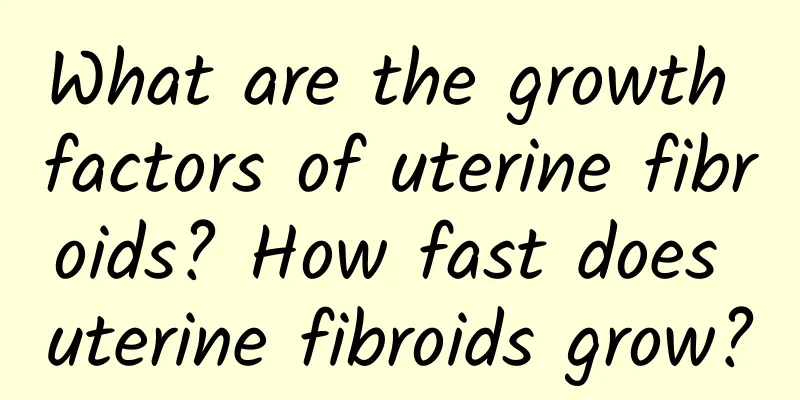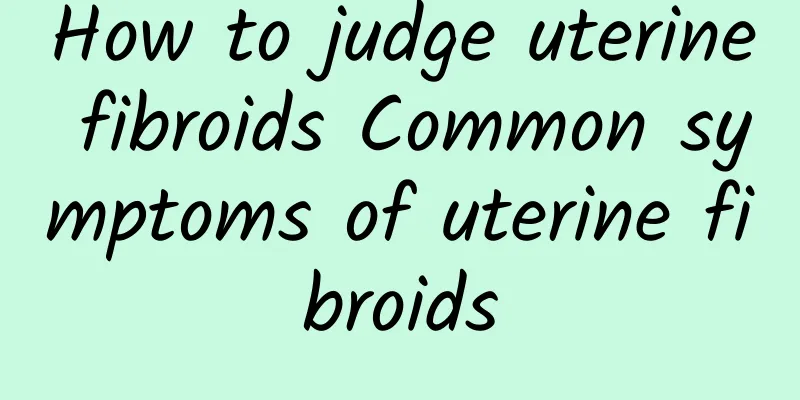Is the chance of uterine fibroids becoming cancerous very high? Is surgery for uterine fibroids necessary?

|
Although uterine fibroids are tumors, they are not that scary. They are benign tumors and are also very common in life. Common symptoms of this disease include irregular menstruation, excessive leucorrhea, and lower abdominal pressure. Generally speaking, if the condition is not serious, no treatment is required. If the condition is serious or the symptoms are obvious, surgery or drug treatment is required. What are the common symptoms of uterine fibroids? 1. Abnormal menstruation. The most obvious manifestation is increased flow and prolonged cycle. Fibroids can change the shape and volume of the uterine cavity, affect the normal function of muscles, compress veins, and affect menstrual bleeding. 2. Lower abdominal mass. As the fibroids in the uterus grow, the patient can feel a noticeable mass from the outside of the lower abdomen. The size of the lower abdomen will gradually increase, accompanied by a noticeable feeling of swelling. 3. Abnormal leucorrhea. The patient's leucorrhea will increase significantly, become thick and have a strange smell. Sometimes, tissue similar to rotting flesh may be discharged with a bad smell. 4. Frequent urination, urgency, or difficulty urinating. As fibroids grow larger, they may compress the bladder or ureters, leading to many abnormalities during urination. 5. Abdominal and body discomfort. Women with uterine fibroids often feel swelling in the lower abdomen, which then develops into back pain or fatigue. This phenomenon becomes more severe during menstruation. 6. Infertility: If a woman's uterine fibroids compress or block the fallopian tubes, the chances of pregnancy will be greatly reduced. 7. Secondary anemia. Long-term prolonged menstruation and increased menstrual volume can easily cause anemia, leading to fatigue, dizziness, palpitations and many other discomforts. 8. Hypoglycemia. This rarely happens and will disappear immediately after the tumor is removed. The patient will feel obvious dizziness or even shock on an empty stomach, which will slowly ease after injecting a little glucose. If the disease is not controlled in time, uterine fibroids may develop into various diseases. Lesions are divided into benign and malignant. Generally, only 0.4% to 0.8% of benign fibroids will turn into malignant tumors, but this does not mean that we do not have to guard against the risk of cancer. Under what circumstances do uterine fibroids require surgery? (1) Excessive menstruation: When uterine fibroids cause excessive menstruation, menorrhagia, or prolonged menstruation leading to anemia, surgery is recommended. (2) Uterine fibroids cause the uterus to significantly enlarge, equivalent to a 3-month pregnancy, and surgery is recommended. (3) If a single fibroid is larger than 5 cm, or if a fibroid is larger than 4 cm in diameter when preparing for pregnancy, surgery is recommended. (4) If the growth of uterine fibroids compresses other pelvic organs, such as the bladder, rectum, or ureters, surgery is recommended. (5) Suspected malignant transformation: Surgery is recommended when the fibroids become malignant, such as when the fibroids grow too fast, continue to grow after menopause, or when ultrasound shows abnormally rich blood flow in the fibroids. (6) For infertile women with normal other conditions, the cause of infertility may be uterine fibroids, and surgery is recommended. (7) For fibroids in special locations, early surgery is recommended. For example, hysteroscopic resection is recommended for submucosal fibroids measuring 2-3 cm. |
Recommend
Lin Fan is not hiding his weight loss! 3 simple yoga moves
Singer Lin Fan has loved sports since he was a ch...
Symptoms of clinical cervicitis in the early stages
The key to controlling the harm of cervicitis is ...
Lose weight during the menstrual cycle and shape your body first! Drink ginseng brown sugar drink
Some people say, "You won't gain weight ...
Why does pelvic inflammatory disease recur?
Why does pelvic inflammatory disease recur? Pelvi...
Patients with ectopic pregnancy need to be cared for in life
Among gynecological diseases, ectopic pregnancy i...
Will ectopic pregnancy cause dizziness and fatigue?
Will ectopic pregnancy cause dizziness and fatigu...
How does Bartholinitis affect life expectancy?
We must understand the main hazards of Bartholini...
Is it normal to get pregnant again after a missed miscarriage?
It is normal to get pregnant again after a missed...
What can't you eat when you have menstrual pain?
What should not be eaten when having menstrual pa...
Common treatments for irregular menstruation
The most common symptom of a woman's physiolo...
A guide to good health! Five rules of life
As the saying goes, "With a healthy body, li...
Drugs for the treatment of bacterial vaginosis
Treatment for bacterial vaginosis may include ant...
Vulvar leukoplakia will affect sexual life
The appearance of white thickening of the vulvar ...
What are the symptoms of primary cervical warts?
What are the symptoms of first-stage cervical war...
The secret of bride's slimming: drink Chinese herbal tea to get rid of fat
Getting married is a major event in life. When th...









